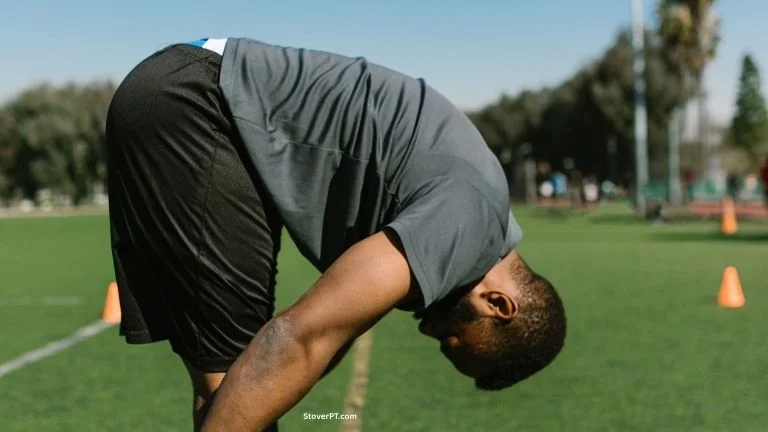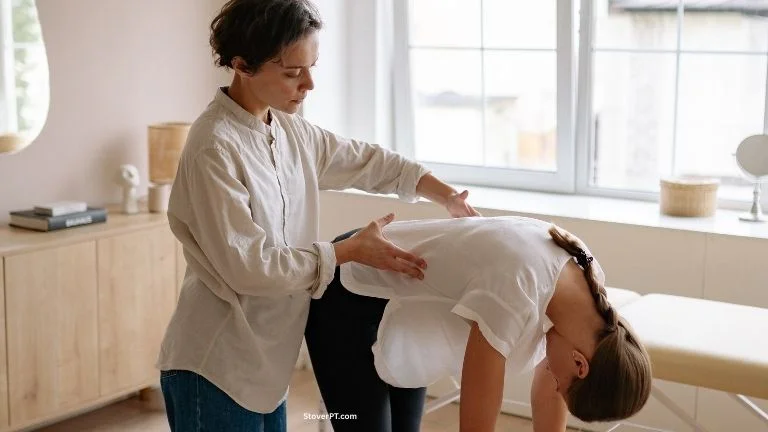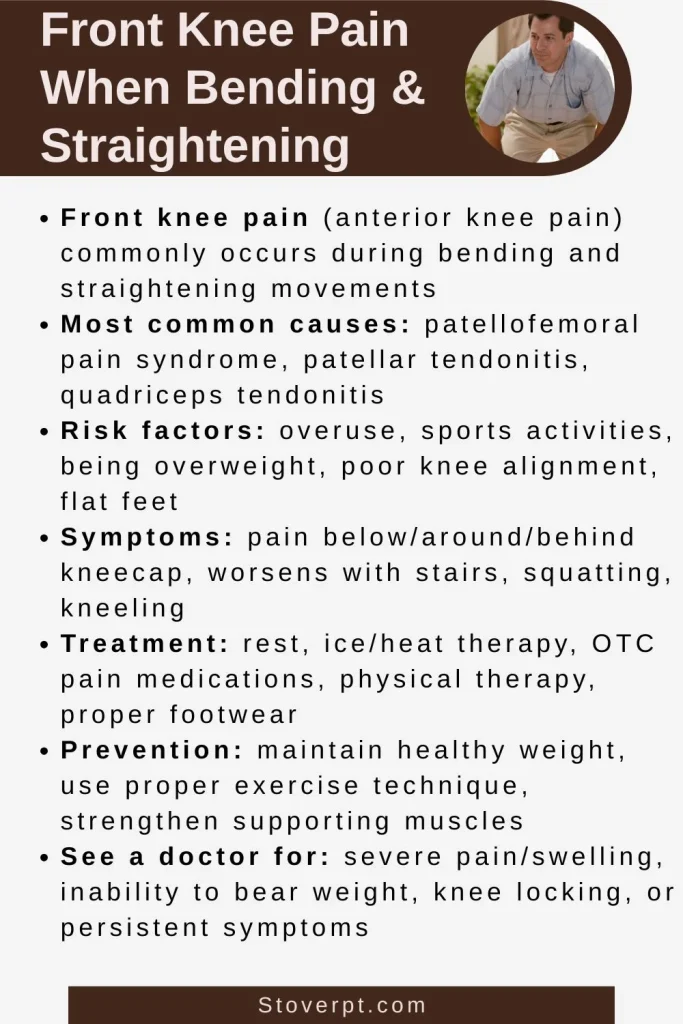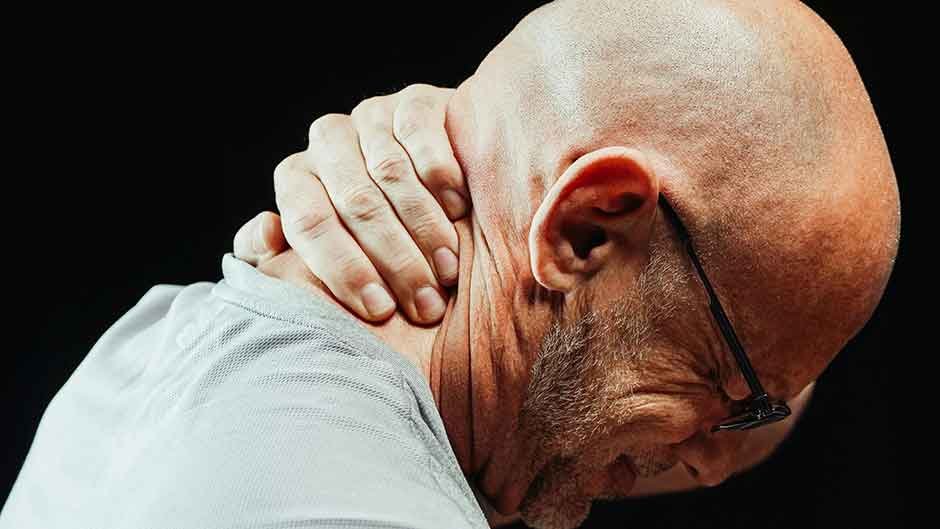Front Knee Pain When Bending & Straightening: Causes & Fixes

Knee pain during bending and straightening often indicates conditions like patellofemoral syndrome, patellar tendonitis, or osteoarthritis, which affect the kneecap area and surrounding structures.
Understanding Knee Pain When Bending and Straightening
Experiencing pain in the front of your knee when performing everyday movements like bending and straightening can significantly impact your quality of life. The knee is a complex joint that bears much of our body weight and is vulnerable to various injuries and conditions. Front knee pain, also known as anterior knee pain, is particularly common and can manifest as a sharp pain, dull ache, or burning sensation.
The discomfort may worsen during specific activities such as climbing stairs, squatting, kneeling, or after sitting for extended periods. Understanding the underlying causes of this pain is crucial for finding appropriate treatment and relief.
Common Causes of Front Knee Pain
Front knee pain when bending and straightening the knee can stem from several conditions:
Patellofemoral Pain Syndrome
Patellofemoral pain syndrome is one of the most common causes of anterior knee pain. This condition occurs when the patella (kneecap) doesn’t track properly over the femur (thigh bone) during knee movements. The misalignment creates excessive pressure on the cartilage beneath the kneecap, resulting in pain when bending or straightening the knee.
This syndrome often develops due to:
- Muscle imbalances, particularly weak quadriceps
- Overuse from repetitive activities
- Poor biomechanics during movement
- Flat feet or overpronation
The pain typically manifests as a dull ache around or behind the kneecap that worsens when climbing stairs, squatting, or sitting with bent knees for extended periods.
Patellar Tendonitis
Patellar tendonitis, also known as jumper’s knee, involves inflammation of the patellar tendon that connects the kneecap to the shinbone. This condition commonly affects athletes who participate in jumping sports like basketball or volleyball.
The primary symptoms include:
- Sharp pain just below the kneecap
- Pain that worsens with activities like jumping, running, or climbing stairs
- Tenderness at the base of the kneecap
- Pain that intensifies when bending or straightening the knee against resistance
Patellar tendonitis develops from repetitive stress on the tendon, leading to small tears that cause inflammation and pain.
Quadriceps Tendonitis
Quadriceps tendonitis affects the tendon that connects the quadriceps muscles to the kneecap. When this tendon becomes inflamed or injured, it can cause pain above or in front of the knee, particularly when straightening the leg.
This condition often results from:
- Sudden, forceful contractions of the quadriceps muscles
- Overuse from repetitive activities
- Age-related degeneration of the tendon
The pain typically localizes to the area just above the kneecap and worsens during activities that involve knee extension, such as walking, climbing stairs, or standing up from a seated position.
Osteoarthritis
Osteoarthritis is a degenerative joint disease where the cartilage that protects the joint wears down over time. As the protective cartilage diminishes, bone rubs against bone, causing pain, stiffness, and reduced range of motion.
Common symptoms include:
- Pain that worsens with activity and improves with rest
- Morning stiffness that typically resolves within 30 minutes
- Grinding or crackling sensation during knee movement
- Swelling around the joint
Osteoarthritis commonly affects older adults but can also develop following knee injuries or in individuals with a family history of the condition.
Meniscus Tears
The meniscus is a C-shaped piece of cartilage that acts as a cushion between your thighbone and shinbone. Tears in the meniscus can cause pain in the front of the knee when bending and straightening the leg.
Meniscus tears often occur during activities that involve twisting or rotating the knee, especially when putting your full weight on it. They can also develop gradually due to age-related degeneration.
Symptoms typically include:
- Pain, especially when twisting or rotating the knee
- Swelling and stiffness
- A popping sensation during the injury
- Difficulty fully straightening the knee
- Feeling as though your knee is locked in place when you try to move it
Ligament Injuries
Ligaments are tough bands of tissue that connect bones and provide stability to joints. The knee contains four main ligaments: the anterior cruciate ligament (ACL), posterior cruciate ligament (PCL), medial collateral ligament (MCL), and lateral collateral ligament (LCL).
Injuries to these ligaments, particularly the ACL, can cause pain in the front of the knee when bending and straightening. Ligament injuries typically result from sudden stops, changes in direction, or direct impacts to the knee.
Symptoms of ligament injuries include:
- Sudden, severe pain
- A popping sound at the time of injury
- Rapid swelling
- Instability or a feeling that the knee will “give way”
- Limited range of motion
Diagnosis of Front Knee Pain
Proper diagnosis is essential for effective treatment of front knee pain. If you’re experiencing persistent or severe pain in the front of your knee when bending and straightening, it’s important to consult a healthcare professional.
Medical History and Physical Examination
Your doctor will begin by taking a detailed medical history, asking about your symptoms, when they started, what makes them better or worse, and any previous injuries or conditions. They will also perform a physical examination to assess:
- Range of motion in your knee
- Stability of the joint
- Areas of tenderness or swelling
- Alignment of your kneecap
- Strength of surrounding muscles
- Gait and posture
Imaging Tests
Depending on the suspected cause of your knee pain, your doctor may recommend one or more of the following imaging tests:
X-rays
X-rays provide images of the bones and can help identify fractures, bone spurs, or signs of osteoarthritis. However, they don’t show soft tissues like ligaments, tendons, or cartilage.
MRI (Magnetic Resonance Imaging)
MRI scans use magnetic fields and radio waves to create detailed images of both hard and soft tissues. They’re particularly useful for diagnosing meniscus tears, ligament injuries, and cartilage damage.
Ultrasound
Ultrasound uses sound waves to create real-time images of soft tissues. It can help diagnose tendon or ligament injuries and is sometimes used to guide injections.
CT Scan (Computed Tomography)
CT scans combine X-rays taken from different angles to create cross-sectional images of the knee. They provide more detailed information about bone structures than regular X-rays.
Additional Diagnostic Procedures
In some cases, your doctor may recommend additional procedures to diagnose the cause of your knee pain:
Arthroscopy
Arthroscopy is a minimally invasive procedure where a small camera (arthroscope) is inserted into the knee joint through a small incision. This allows the doctor to directly visualize the structures inside the knee and can be both diagnostic and therapeutic.
Joint Fluid Analysis
If there’s significant swelling in your knee, your doctor may extract and analyze some of the fluid to check for infection, inflammation, or crystals that could indicate gout.

Treatment Options for Front Knee Pain
Treatment for front knee pain when bending and straightening depends on the underlying cause, severity of symptoms, and individual factors. Most cases can be managed with conservative approaches, while more severe conditions might require medical interventions.
Home Remedies and Self-Care
For mild to moderate knee pain, the following self-care measures may provide relief:
Rest and Activity Modification
Reducing or avoiding activities that exacerbate your knee pain is crucial for recovery. This doesn’t necessarily mean complete immobilization but rather modifying activities to minimize stress on the knee joint.
Ice and Heat Therapy
Applying ice to your knee for 15-20 minutes several times a day can help reduce pain and inflammation, especially after activity. Heat therapy may be beneficial for relieving stiffness, particularly before exercise or stretching.
Over-the-Counter Pain Medications
Nonsteroidal anti-inflammatory drugs (NSAIDs) like ibuprofen or naproxen can help manage pain and reduce inflammation. Always follow the recommended dosage and consult your doctor if you have any underlying health conditions.
Compression and Elevation
Wearing a compression bandage and elevating your knee above heart level can help reduce swelling and provide support to the joint.
Physical Therapy
Physical therapy plays a crucial role in treating front knee pain and preventing recurrence. A physical therapist can develop a personalized exercise program targeting your specific condition and goals.
Strengthening Exercises
Strengthening the muscles that support the knee, particularly the quadriceps and hamstrings, can improve stability and reduce pressure on the joint. Some effective exercises include:
- Straight leg raises
- Wall sits
- Step-ups
- Hamstring curls
- Mini squats (avoiding deep knee bends)
Flexibility Exercises
Stretching exercises help improve flexibility and range of motion while reducing tension in the muscles around the knee. Focus on stretching the:
- Quadriceps
- Hamstrings
- Calves
- IT band
Balance and Proprioception Training
Exercises that improve balance and body awareness can enhance joint stability and prevent future injuries. These might include:
- Single-leg stands
- Balance board exercises
- Wobble board training
- Tai chi or yoga
Medical Treatments
If conservative measures don’t provide sufficient relief, your doctor may recommend more advanced treatments:
Medications
Prescription-strength NSAIDs or other pain medications may be prescribed for more severe pain. In some cases, corticosteroid injections might be recommended to reduce inflammation, though these should be used sparingly due to potential side effects on cartilage and tendons.
Orthotics and Bracing
Custom orthotics or knee braces can help correct alignment issues, provide support, and reduce pressure on the affected area. Patellar taping techniques may also help improve kneecap tracking and reduce pain during movement.
Injections
Besides corticosteroids, other injection options include:
- Hyaluronic acid injections (viscosupplementation): These provide lubrication and cushioning in the joint, particularly beneficial for osteoarthritis.
- Platelet-rich plasma (PRP): This uses components of your own blood to promote healing in damaged tissues.
- Stem cell therapy: Though still considered experimental for many knee conditions, this approach aims to promote tissue regeneration.
Surgical Options
Surgery is typically considered only when conservative treatments have failed to provide relief or in cases of severe injury or degeneration:
Arthroscopic Surgery
This minimally invasive procedure allows surgeons to repair or remove damaged tissue through small incisions. It may be used to treat meniscus tears, remove loose bodies, or smooth damaged cartilage.
Patellar Realignment
For recurrent patellar tracking issues, surgery may be performed to realign the kneecap and improve its movement within the trochlear groove.
Partial or Total Knee Replacement
In severe cases of osteoarthritis or other degenerative conditions, replacing part or all of the knee joint with artificial components may be necessary to relieve pain and restore function.
Prevention Strategies
While not all causes of front knee pain can be prevented, several strategies can reduce your risk of developing or exacerbating knee problems:
Maintain a Healthy Weight
Excess weight places additional stress on your knee joints. For every pound of weight lost, there’s a four-pound reduction in the load exerted on the knee during daily activities.
Use Proper Technique During Physical Activities
Whether you’re exercising, playing sports, or performing daily tasks, using proper form and technique can significantly reduce the risk of knee injuries. Consider working with a trainer or physical therapist to ensure correct movement patterns.
Wear Appropriate Footwear
Shoes with good support and cushioning can help absorb shock and reduce stress on your knees. Replace worn-out athletic shoes regularly and consider orthotics if you have foot alignment issues.
Gradually Increase Activity Levels
Sudden increases in the intensity, duration, or frequency of physical activities can overload your knee joints. Follow the 10% rule: increase your activity level by no more than 10% per week.
Incorporate Low-Impact Exercises
Activities like swimming, cycling, and elliptical training provide cardiovascular benefits without placing excessive stress on your knees. These can be excellent alternatives or complements to higher-impact activities.
Strengthen Supporting Muscles
Regular exercises to strengthen the muscles around your knees, hips, and core can improve joint stability and reduce the risk of injuries. Focus particularly on the quadriceps, hamstrings, and hip abductors.
Maintain Flexibility
Regular stretching helps maintain good range of motion in your joints and reduces tension in the muscles and tendons around your knees. Include stretching as part of your warm-up and cool-down routines.
When to See a Doctor
While many cases of front knee pain can be managed with self-care measures, certain symptoms warrant prompt medical attention:
- Severe pain or swelling
- Inability to bear weight on the affected leg
- Visible deformity of the knee
- Popping or cracking sound at the time of injury
- Inability to fully bend or straighten the knee
- Signs of infection (redness, warmth, fever)
- Pain that persists or worsens despite rest and home treatments
- Recurrent episodes of knee pain or giving way
Early intervention can prevent further damage and improve outcomes, so don’t hesitate to consult a healthcare professional if you’re concerned about your knee pain.

Frequently Asked Questions
Why does my knee hurt when I bend it but not when I straighten it?
Pain specifically during knee bending but not straightening often indicates issues with the structures at the front of the knee, such as the patellofemoral joint or patellar tendon. Activities that increase pressure on these structures, like squatting or climbing stairs, typically worsen the pain. This pattern is common in conditions like patellofemoral pain syndrome or patellar tendonitis.
Can knee pain when bending and straightening go away on its own?
Minor knee pain from overuse or mild strains may improve with rest, ice, compression, and elevation (RICE protocol). However, persistent or recurring pain typically indicates an underlying condition that requires proper diagnosis and treatment. Without addressing the root cause, the pain may worsen over time or lead to additional problems.
How long does it take to recover from knee pain?
Recovery time varies greatly depending on the cause and severity of the knee pain. Minor strains or overuse injuries might improve within a few weeks with appropriate rest and self-care. More significant injuries like meniscus tears or ligament sprains typically require 6-8 weeks or longer. Chronic conditions like osteoarthritis may require ongoing management rather than complete resolution.
Can being overweight cause knee pain when bending and straightening?
Yes, excess weight places additional stress on the knee joints during all movements, including bending and straightening. For every pound of body weight, the knees experience approximately 3-4 pounds of pressure during activities like walking. This increased load can accelerate wear and tear on the joint, leading to pain and potentially contributing to conditions like osteoarthritis.
What exercises should I avoid if I have front knee pain?
If you have front knee pain, it’s generally advisable to avoid or modify activities that place excessive stress on the patellofemoral joint, such as:
- Deep squats or lunges
- Running downhill or on hard surfaces
- High-impact jumping activities
- Prolonged kneeling
- Stair climbing (especially descending)
A physical therapist can help you develop a safe exercise program that strengthens the knee without exacerbating pain.





